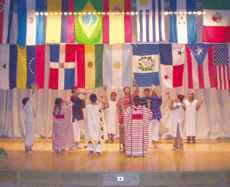The Dorchester Open Studios
October 31, 2002
The Dorchester Open Studios is the first neighborhood-wide event of this type in the community. No longer is Pearl Street the only way to get to know the artists of Dorchester. There are dozens of locales to sample what each creator has to offer. This is just one of many community programs being put on all around Boston by the 2002 Boston Open Studios Coalition as part of introducing the public to the arts community and what it has to offer.
On October 26, the Dorchester Open Studios resembled a ghost town. Whether it was the freezing rain or the nearly inaccessible locations of many of the artists’ works, the weather itself drove many people indoors to huddle by the warmth of their radiators. The event was not helped by the fact that several of the places in question, like Strong Coffee, were closed.
Just as I was about to get my rain-soaked self back to my apartment, I spied a green banner proclaiming the “Open Studios.” And that was how I was able to drop in at 195 Boston Street, home to the Dorchester Historical Society where I met Francis Domec and Daniel Medrano; the former works with collage, collagraphs and sand painting on paper while the latter prefers to work in the abstract, dealing with oils and acrylics.
Medrano was born and raised in Rome but moved to Argentine where he works as an actor and a painter. Most of his works were color fields and nonrepresentational storms of multi-hued pastels. Though he loves all of the arts, he enjoys not only the canvas but the stage.
One of his more notable creations is Bodies, displaying in magenta and blue what appear to be merely curving colors. However, the window on the right appears to be an inverted torso; a woman’s hip cresting and merging as the line moves towards her bust while the box on the left looks like the upper thigh sliding down to the point of a kneecap.
“The good thing about abstract art is you can see whatever you want in it,” Medrano commented.
If Medrano is about amorphous, interpretive artwork, then Domec is his opposite in his fascination with primitivism, geometric shapes, and tribal expressions. With Woman Posing, a hand painted collagraph on paper, he combines the shades of a fiery sunset with the onyx-hued shape of a woman’s face.
“A mask is an expression of a face, but it is not a face,” is how Domec puts it. He manages to add in the sand to give the face a grainy texture and build it outward slightly, giving it life and a subtle, three-dimensional depth.
Although it was sparsely attended, it was interesting to get a taste and feel for the work that originates out of the Dorchester area.





















































